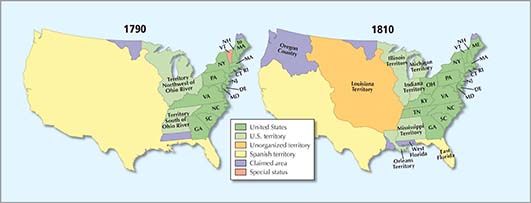CHAPTER 6: Quick Study Guide
Progress Monitoring Online
For: Self-test with vocabulary practice
Web Code: nca-1651
- Establishing Important Precedents
Date Precedent 1789 Cabinet Washington sets up the group of federal leaders who head major departments and advise the President. 1789 Judiciary Judiciary Act establishes a Supreme Court, the federal court system, and the office of Attorney General. Around 1792 Political parties A two-party system, made up of Federalists and Democratic Republicans, emerges. 1797 Two terms for Presidents Washington retires after two terms in office. 1801 Peaceful transfer of power With Jefferson’s election, power transfers peacefully from one party to the other. 1803 Judicial review The Supreme Court case Marbury v. Madison establishes judicial review. - Major U.S. Conflicts, 1794–1812
Date Event Cause/Significance 1794 Whiskey Rebellion People on frontier protest whiskey taxes; First challenge facing the new government 1794 Battle of Fallen Timbers Native Americans resist American expansion, aided by the British; American victory opened Northwest Territory 1801 Barbary War Barbary States seize American ships and sailors; First American victory overseas 1811 Battle of Tippecanoe Native Americans led by Tecumseh resist American expansion; American victory weakens Native American movement 1812 War of 1812 Americans blame Britain for various problems; War strengthens national unity; defeat of Native Americans opens up vast lands for settlement - U.S. Territorial Expansion
 Quick Study Timeline
Quick Study Timeline
For: Interactive timeline
Web Code: ncp-0651






